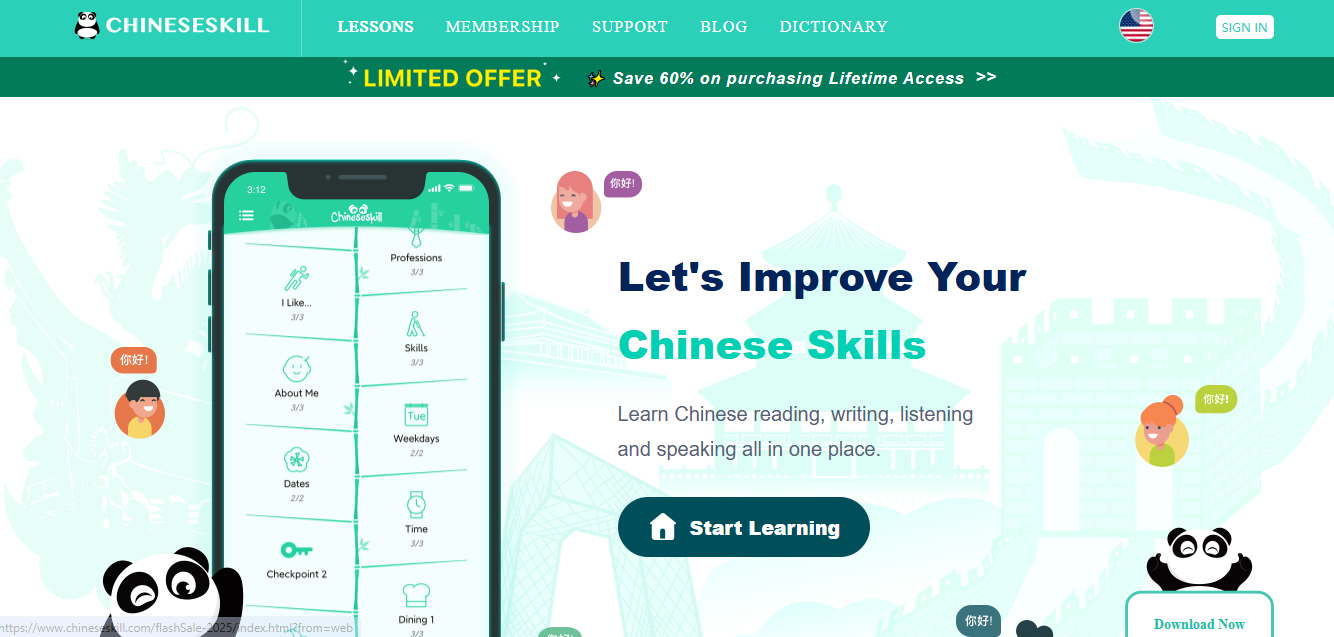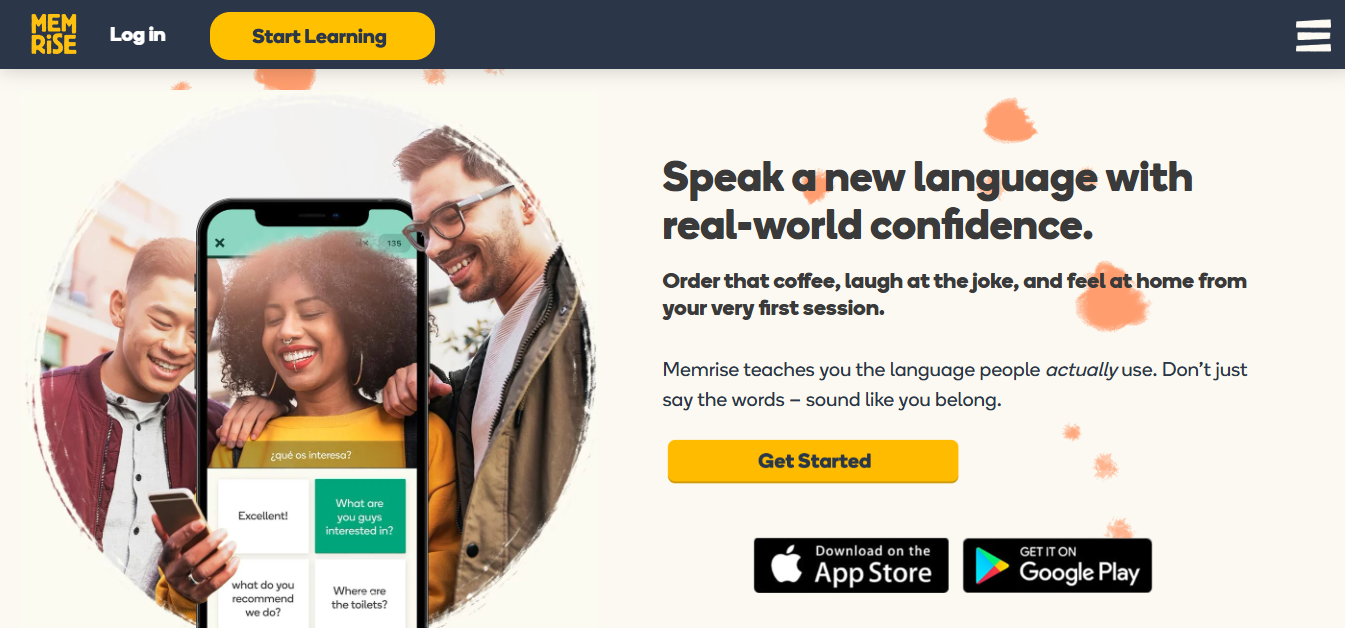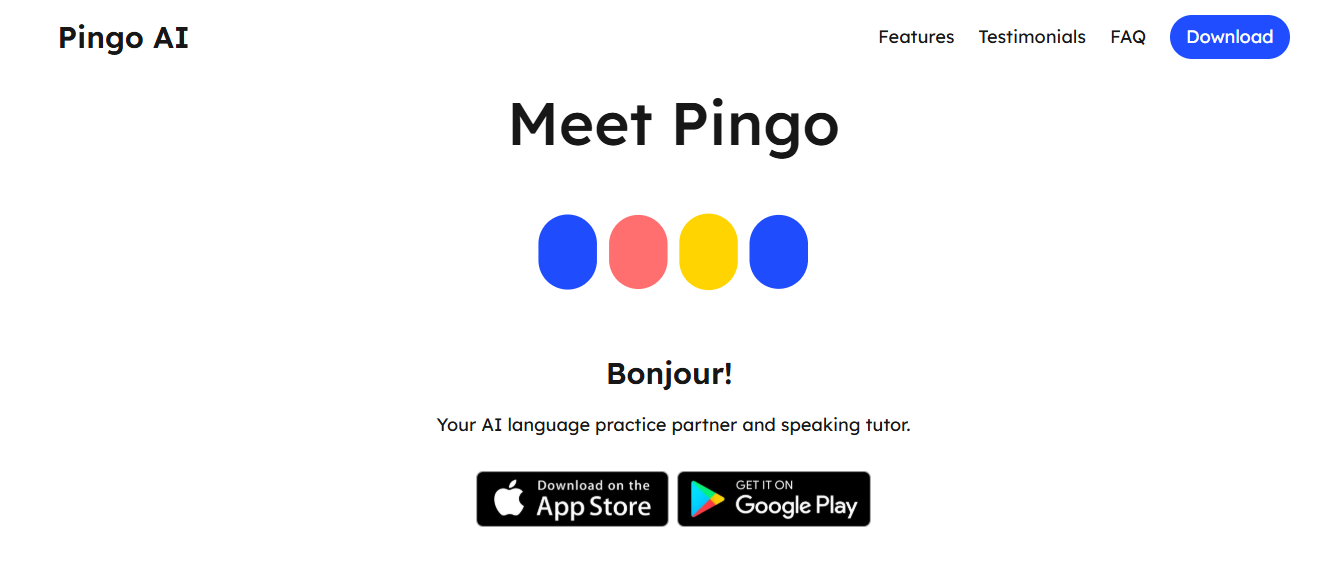25 Best Apps to Learn Mandarin & How to Choose the Best App

Michael Xing, Founder of Pingo AI
In the world of top language learning apps, the best apps to learn Mandarin matter because Mandarin needs focused work on pronunciation, pinyin, hanzi, and grammar. This article breaks down top Chinese language apps, comparing features like spaced repetition, speech recognition, tutor chats, and character writing so you can pick the right fit.
Pingo AI makes that search easier by offering an AI language learning app with personalized lessons, instant pronunciation feedback, and conversation practice that fits your level, plus vocabulary drills, HSK-style quizzes, and hanzi writing practice to keep your progress on track.
Summary
- Focused speaking practice drives usable fluency, with over 70% of Mandarin learners preferring apps that offer interactive features, which suggests hands-on rehearsal beats passive points-based study for real conversation readiness.
- Adaptive, personalized paths matter for retention. Apps that offer customized learning paths see a 50% increase in user retention, showing that tailored placement and error-driven progression reduce wasted weeks on material you already know.
- The language app market is scaling fast, valued at USD 6.34 billion in 2024 and projected to expand from USD 7.36 billion in 2025 to USD 24.39 billion by 2033, indicating sustained investment in better speaking and feedback features.
- You can avoid character overload by prioritizing core literacy. Chinese has over 50,000 characters, but roughly 2,500 are needed for basic literacy, so focusing on speaking plus a targeted character set accelerates usable comprehension.
- Run a short, rigorous trial to see accurate transfer, for example, pick three conversational outcomes, schedule four short roleplays per week, and compare spoken minutes and specific corrections before and after two weeks to measure real gains.
- Technical capabilities determine whether practice transfers to real life, so demand voice recognition that labels error types, exportable recordings, and clear privacy options, especially given that over 1 billion people worldwide speak Mandarin and that fundamental interactions vary widely.
- This is where Pingo AI's AI language learning app fits in, offering on-demand roleplays, instant pronunciation feedback, Tutor Mode, and adaptive correction to help convert passive review into repeated spoken practice.
25 Best Apps to Learn Mandarin
1. Pingo

Pingo prioritizes speaking from day one with expressive AI that simulates real-life dialogues, gives instant pronunciation and tone feedback, and adapts to your level. Use it for targeted roleplays, repeating short scenarios until phrasing and tone feel natural, then raise the difficulty and record improvement over the weeks. Best for learners who want fast, confident speaking practice rather than passive memorization.
2. Anki

Anki is open-source spaced repetition software (SRS) that you can personalize with decks for characters, words, and sentences. Its strength is retention; schedule-friendly reviews ensure vocabulary stays available when you need it in conversation. Pair Anki with short Pingo sessions to put the words you review into spoken use within 24–48 hours.
3. Pleco

Pleco is the go-to offline dictionary with native audio, handwriting character input, and camera-based OCR. Use it as your lookup lifeline when a conversation throws an unknown character or phrase at you; a quick lookup keeps the dialogue flowing and reduces frustration on the spot. Pleco’s add-ons, like flashcards, complement spoken practice by clarifying meaning instantly.
4. Pimsleur

Pimsleur focuses on 30-minute audio lessons that force you to speak and reply, training recall under conversational timing. It is strong for beginners who want to internalize rhythm and response patterns, not just vocabulary lists. Use Pimsleur to build automatic speech routines, then test them in AI role-plays to accelerate real-world transfer.
5. Duolingo

Duolingo gamifies bite-sized lessons to build vocabulary and grammar habitually, which helps with consistent exposure. The app’s engagement mechanics keep streaks alive, but that can mask gaps in speaking readiness; treat Duolingo as spaced input rather than the sole path to fluency. Slot brief Duolingo sessions before live speaking practice to warm up recall.
6. Skritter

Skritter teaches characters with stroke-by-stroke handwriting recognition and SRS for durable recall. It is the fastest route to clean, legible writing and deeper character memory, which in turn clarifies tone associations tied to characters. For learners who avoid characters, use Skritter minimally, only for the most frequently used forms you will say aloud.
7. Zizzle

Zizzle anchors characters in vivid micro-stories and images so meaning and shape stick together, helping you recall them without rote repetition. It is excellent for visual memory work when you prefer a narrative hook over mechanical drills. After Zizzle sessions, practice pronouncing the example phrases out loud to attach sound to the mage.
8. FluentU

FluentU offers real-world videos with interactive subtitles and quizzes that expose you to natural speech patterns across registers. It accelerates listening comprehension and contextual vocabulary, skills that inform how you speak and respond. Use FluentU clips as prompts for mimicry, such as shadowing short lines, then recreate them in chat-based roleplays.
9. Chinese Skill

Chinese Skill uses games and structured lessons to move beginners to intermediate competency, and it covers grammar, vocabulary, and characters in clear progressions. It’s practical for regular practice when you need a guided curriculum without heavy production. Complement it with focused speaking sessions to convert passive learning into active usage.
10. The Chairman’s Bao for Reading Chinese News

The Chairman’s Bao supplies graded news-style lessons across levels, ideal for building reading fluency and topical vocabulary. It is beneficial when preparing for HSK reading tasks and for learners who want text-based exposure to contemporary language. After reading an article, summarize it aloud in a Pingo roleplay to train spoken synthesis.
11. LingoDeer

LingoDeer delivers well-structured Chinese courses with solid grammar explanations and a roughly HSK-level progression. It is useful when you want a paced curriculum that explains why grammar works. Use LingoDeer to build accurate grammar frames, then test them in open-conversation simulations.
12. Memrise

Memrise pairs user-created content with native-speaker clips to build pragmatic listening and recall skills, with several community courses in Mandarin. It works well for exposure to varied pronunciations and colloquial phrasing. After a Memrise review, jump into a short, targeted Pingo scenario that uses the exact phrases to cement active recall.
13. ChinesePod

ChinesePod hosts thousands of audio and video lessons across levels and topical themes, letting you choose pragmatic lessons that match immediate needs. Its episodic approach works well for spiral learning, returning to themes at increasing depth. Try scheduling a ChinesePod lesson, then roleplay the dialogue in a Tutor Mode session to close the loop.
14. Speechling

Speechling emphasizes spoken correction, like you listen to native recordings, record yourself, and receive coaching feedback on intonation and phrasing. It is one of the few tools explicitly built to close the gap between hearing and native-like speaking. Use Speechling for targeted pronunciation cycles, then test fluency in free-form roleplays.
15. Ninchanese

Ninchanese gamifies a comprehensive study with hundreds of structured lessons spanning reading, writing, listening, and speaking. It helps sustain long practice windows through points and missions, which matters when consistency is the limiting factor. Alternate Ninchanese study blocks with speaking drills so game-earned gains translate to conversation.
16. HSK Online

HSK Online delivers mock tests, targeted practice, and AI-driven error analysis across HSK 1 to 6. It is the most efficient way to prepare for exam mechanics and timing while tracking readiness. Mix HSK drills with scenario-based speaking sessions to ensure test vocabulary becomes usable language rather than just test knowledge.
17. Du Chinese

Du Chinese offers graded reading content with translations, audio, and instant lookups to build reading fluency and listening comprehension together. Its clean interface makes it fast to read multiple short lessons in one sitting, boosting exposure density. After reading, synthesize aloud what you read in a 3-minute spoken summary to practice instant recall.
18. Language Drops

Language Drops focuses on quick, visually driven vocabulary sessions you can complete in 5 minutes, perfect for daily micro-practice. It helps build a broad vocabulary through imagery and rapid repetition. Use Drops for daily warm-ups, then spend longer blocks on speaking-focused practice to build retrieval under pressure.
19. HiNative

HiNative connects learners with native speakers who answer pronunciation, usage, and cultural questions, giving human nuance that automated content often misses. It’s fast for targeted clarifications and phrase checks. Keep questions concise and then rehearse the corrected phrasing aloud to lock in both accuracy and muscle memory.
20. Busuu

Busuu combines structured lessons, AI grammar review, and community feedback with customizable study plans that adapt to your schedule. It balances a classroom-like structure with opportunities for social practice. Pair Busuu’s review cycles with simulated conversations that mirror the app’s lesson topics to practice applying new grammar in speech.
21. Beelinguapp

Beelinguapp presents bilingual readings with audio side-by-side so you can read and listen simultaneously, which is effective for contextual vocabulary learning. It is beneficial for intermediate learners who want to boost listening comprehension and reading speed. After listening, recite key paragraphs aloud to internalize rhythm and intonation.
22. HelloTalk

HelloTalk matches you with native speakers for text, voice, and short audio exchanges; it is built around correction tools and transliteration. For real conversational practice, it gives authentic, unpredictable input you will not get from scripted lessons. Use HelloTalk for short, high-frequency exchanges, then refine recurring errors in controlled AI tutor sessions.
23. ChineseClass101

ChineseClass101 supplies short, topic-driven audio and video lessons that you can search by level and subject, ideal for targeted skill gaps. Its bite-sized format makes it easy to fit practice into a busy schedule while covering practical topics. Follow a lesson and immediately practice the same script aloud, aiming to match rhythm and intonation.
24. Rosetta Stone

Rosetta Stone uses immersive, context-first lessons that minimize translation and force associative learning, which trains you to think in the language. It is helpful for early immersion and for learners who respond well to visual-context learning. Combine short Rosetta Stone sequences with immediate spoken drills to preserve the momentum of intuitive understanding.
25. Hack Chinese

Hack Chinese is a web-based SRS tool focused on vocabulary acquisition and test prep, with graded readings and frequency lists tailored for exams such as the HSK and TOCFL. Fifteen to twenty minutes per day yields steady growth in active vocabulary, especially when combined with pronunciation practice. Use it to build the raw word bank, then prioritize speaking those words in scenario-rich practice.
Related Reading
- Babbel vs Duolingo
- How Much Is Duolingo Max
- How Much Does Babbel Cost
- Rosetta Stone vs Duolingo
- Best Apps to Learn Spanish
- Best Apps to Learn Japanese
- Busuu vs Duolingo
- Duolingo Alternatives
What Makes an Effective Language Learning App?

An effective language learning app proves itself by producing measurable spoken progress, not just daily streaks. You want tools that force production, give precise corrections, and let you practice realistic conversations repeatedly until phrasing and tones become automatic.
What Shows that an App Actually Builds Speaking Ability?
Look for transfer signals, not vanity metrics. Priority one is raw speaking time per week, tracked in the app, because minutes spent speaking directly correlate with fluency gains. Next, check whether the app measures speaking performance across varied contexts.
For example, counting distinct roleplays or scenario types completed, and whether it timestamps repeated attempts so you can see improvement over days.’ Finally, pay attention to feedback density, the share of sessions that include explicit corrections you can act on immediately, not just a percentile score.
How Should Corrective Feedback Feel in Practice?
Feedback should read like a coach’s note, not a grade. That means specific corrections of the phrase you just said, an example of a cleaner alternative, and a short drill that isolates the troublesome sound or structure.
If the app only shows a correctness percentage or an opaque fluency score, it isn't helping you rehearse the fix. The best systems offer micro-repeats, immediate modeling, and a simple cue to try again within the same scenario, so the correction is applied in context.
When Do Engagement Mechanics Help, and When Do They Sabotage Learning?
This pattern appears across mainstream gamified apps, where mechanics that limit session length or ration usage can feel punitive and break momentum, leading to frustration that drives people away.
Gamification helps when it scaffolds progressive challenge and rewards mastery, not when it interrupts a good practice run or penalizes correct effort. If you find yourself pausing mid-conversation because the app forces a wait, that is a signal that the mechanics are working against your learning, not for it.
How Do You Run a Rigorous Two-Week Test Drive?
Treat your trial like a tiny experiment. Pick three conversational outcomes you care about, for example, ordering food, negotiating a price, and making plans. Schedule four short roleplays per week, log the time you actually speak, and rate your confidence before and after each session.
At the end of two weeks, compare:
- Average spoken minutes per session
- Number of specific corrections applied
- Subjective ease in unrehearsed replies
That comparison tells you whether the app creates usable speaking habits or just comfortable review mechanics.
What Technical Features Matter Under the Hood?
Prioritize adaptive personalization that adjusts the difficulty of scenarios based on your mistake patterns, not arbitrary lesson levels. Voice recognition must provide actionable error types, such as tone, vowel quality, or omission, rather than vague miss/ok flags.
Also, check data portability and privacy options, because you may want to export your progress or remove recordings. Finally, ensure the breadth of the scenario matches your goals; apps that sample widely across registers and settings will prepare you for fundamental interactions faster.
How to Choose the Right Mandarin App for You

Choose the app that solves the immediate speaking problem you care about, then verify that the feedback it gives is precise, repeatable, and tied to real-world scenarios you will use. Narrow toward apps that place you at the right level, give targeted corrections you can act on, and let you repeat the same interaction until phrasing and tones feel automatic.
How Should I Match an App to the Exact Speaking Outcome I Want?
Match the app to a single output. If you want to handle short transactions, pick one that surfaces quickly, repeatable roleplays. If you need to carry on a longer conversation, favor scenario breadth and escalating prompts that force you to extend answers. A simple rule is that the tool should let you practice the smallest real exchange you fear most, then let you chain those into longer dialogs.
Which Design Signals Prove the Feedback Is Useful?
Ask for error detail, not scores. Look for feedback that labels the error type, for example, tone misclassifications, dropped syllables, or misplaced particles, and then offers a micro-drill that isolates that exact issue.
Demand examples you can imitate, plus an immediate retry in the same context. That pattern is what turns correction into muscle memory, the way a coach corrects a single motion on every repetition until it becomes automatic.
What Do Placement and Personalization Actually Buy You?
This pattern appears across beginners and intermediates. Apps that lack proper placement waste your time on material you already know, which drains motivation and progress. Apps that adapt to your mistakes and change the path you follow compress practice into fewer, higher-quality sessions.
In fact, apps that offer personalized learning paths see a 50% increase in user retention. That tells you personalization is not a nicety; it is the single design choice that keeps you practicing long enough to matter.
Why Do Interactive Features Matter More Than Flashy Gamification?
Over time, learners choose tools that let them speak, not just tap, and usage patterns confirm it. Over 70% of Mandarin learners prefer apps with interactive features. Interactive practice signals that users want hands-on rehearsal, not passive points. So treat streaks and badges as engagement seasoning, not the main course.
What Should I Check in the Fine Print Before Subscribing?
Look at voice-data retention, export options, and offline capabilities, because you will want to review your own recordings and keep them private. Confirm whether assessment judgments are mostly automated or if human review is available for edge cases.
Compare actual cost over 6 to 12 months, not just the monthly price, and test refund or cancellation policies. These details control your long-term flexibility and whether you can turn short bursts of practice into sustained progress.
Pingo: Learn Mandarin Through Real Conversations
Pingo's AI language learning app emphasizes conversation-first practice with expressive AI, adaptive feedback, personalized exercises, and two unique modes for beginners and advanced learners to make speaking feel natural. Start speaking with Pingo for free today and experience how learning by talking accelerates absolute confidence.
Related Reading
- Memrise vs Duolingo
- Best Apps to Learn French
- Lingodeer vs Duolingo
- Pimsleur vs Babbel
- Jumpspeak vs Duolingo
- Best Apps to Learn Arabic
- Best Apps for Learning English
- Best Russian Learning Apps
10 Best Extra Tips for Learning Mandarin

Start with pronunciation and consistent speaking practice, then layer reading and characters so sound leads meaning, not the other way around. Use each tip as a rehearsal, not a syllabus, and turn passive input into spoken output every day.
1. Start with Pinyin
Pinyin is your pronunciation blueprint, so treat it as training wheels for the mouth: learn the initials, finals, and the four tones through targeted drills, not passive lists. Practice minimal pairs aloud, record short phrases, and immediately compare your recording to a native model to catch tone drift. When you read new words, say the pinyin out loud before you look at the character, then repeat until the sound is automatic.
2. Grab a Children's Book
Children’s books give you packaged vocabulary and natural repetition, which makes speaking practice manageable. Read a short page aloud, then retell the scene in one or two sentences from memory, paying attention to tone and rhythm. Use the pictures to cue vocabulary, and rehearse the same page three times across two days, each time making your spoken version slightly longer.
3. Try Manga, or Manhua (漫画 - màn huà)
Save manhua for the stage when characters feel less foreign and conversational timing matters more than translation. Read a speech bubble, speak it aloud with its emotional intent, then shadow the line to match pacing and emphasis. Because manhua dialogue often lacks pinyin, it forces you to infer pronunciation from context, which is excellent practice once you have a basic spoken foundation.
4. YouTube
Pick two channels, one language-education focused and one that covers a hobby you care about, and treat videos as speaking prompts. Pause at a natural beat, predict the following sentence, and then say it aloud; replay to check tone and word choice. Shadow content in 15 to 30-second segments, then improvise a one-sentence reply as if you were in the video, keeping the exchange active.
5. Study Abroad
If you can travel, structure your time around daily, short-term speaking goals, for example, order food in Mandarin three times a day and record those attempts.
If travel is not possible, create micro-immersions locally, such as attending community events or visiting markets where Mandarin is spoken. These mini-immersions compress the same pressure, forced production, and cultural feedback that full-time study abroad gives.
6. Practice, Practice, Practice
This is not about random repetition; it is about deliberate rehearsal with constraints. Schedule four focused speaking sessions weekly, each 15 to 25 minutes long, where you force yourself to use new phrases in at least two different ways. Track what you say, note recurring errors, then design the next session to fix one of those errors by repeating the troublesome structure ten times in context.
7. Ask for Help
Pattern recognition shows that when learners get stuck on a phrase, they stall for days. If a native speaker corrects you, don’t just accept the fix; ask for an example sentence, then repeat it three ways. Treat corrections as micro-lessons. Write the corrected phrase, record it, and replay it until the muscle memory follows the correction.
8. Watch Chinese TV Shows
Use shows as active labs, not background noise. Choose a short scene, listen twice, then write a two-line script summarizing what happened and say it aloud with the same emotions. Turn subtitles into cues:
- First watch with your native-language subtitles
- Second with Mandarin subtitles
- Third time, mute and act out the lines while speaking them
This forces you to parse natural pacing and colloquial phrasing.
9. Make Notes
Convert your notes into a private speaking workbook. Instead of only listing words, write tiny roleplay prompts that use those words, then speak the prompts aloud. Keep an audio folder labeled by error type, for example, tone mistakes or particle misuse, and review those clips weekly so corrections become habits rather than one-off fixes.
10. Label Things
Label items with the character, pinyin, and a short sample sentence you will say whenever you use the object. For instance, when you open the fridge, say the sentence aloud. This turns passive visual cues into immediate speaking triggers, and over the course of weeks, the habit reduces the cognitive gap between recognition and production.
Start Learning A Language with Pingo for Free Today

If you want practice that actually changes how you speak, not just how many lessons you check off, consider Pingo, because it makes realistic conversation a habit and forces repeatable corrections that build confidence.
Real users back that shift cause 90% report improved speaking skills within 3 months. Pingo AI has over 1 million downloads, so try the free tier and start speaking today.
Related Reading
- Best Apps for Learning Korean
- Best Apps for Learning Spanish
- Best Apps for Learning Portuguese
- Best Apps for Learning Spanish
- Best Apps for Learning Russian
- Best Apps for Learning Italian
- Best Apps for Learning German
- Best Apps for Learning English
- Best Russian Learning Apps